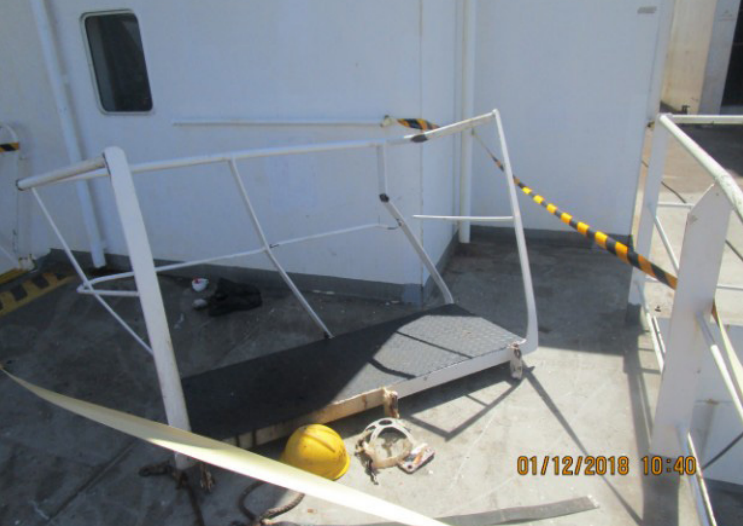The Republic of Marshall Islands Maritime Administrator issued an investigation report on a fatal fall onboard the bulk carrier ‘Penelope’ while underway in the Coral Sea in November 2018. A seafarer was standing on the extension platform for one of the ship’s provision cranes which detached and fell 8-9 meters. The seafarer was wearing a safety belt with a line connected to the handrail on the extension.
The incident
On 26 November 2018, the Marshall Islands-flagged Penelope was underway in the Coral Sea on a ballast voyage from Yeosu, Republic of Korea to Newcastle, Australia.
At about 16:00 hrs, an Able Seafarer Deck (ASD) and an Ordinary Seafarer (OS) were performing routine maintenance on the port side provision crane.
The OS was standing on the Bridge Deck near the port side crane assisting the ASD. The ASD was standing on the platform extension.
Both were wearing coveralls, gloves, safety boots, and safety helmets. The ASD was also wearing a safety belt with a line connected to the handrail on the extension.
At approximately 1655, the platform extension detached and fell to the port side Lifeboat Deck. The platform extension was approximately 8-9 m above the Lifeboat Deck before falling.
The ASD was standing on the platform extension when it detached. His safety line was attached to the railing on the platform extension, which caused the ASD to fall together with the platform about 8-9 meters to the Lifeboat Deck.
When the platform extension and the ASD fell, the OS was getting some extra rags and was looking away from the crane. He did not see what happened but reported hearing a loud noise.
He died as a result of injuries sustained from the fall.

Conclusions
The following Conclusions are based on the above Findings of Fact and Analysis and shall in no way create a presumption of blame or apportion liability:
1. Causal factors that contributed to this very serious marine casualty include:
- the design of the connection of the two parts of the lower stage of the portside provision crane was inherently weak and prone to failure. It was based on three short welded brackets and it did not include mechanical connections joining the railing on the two parts of the lower stage;
- the failure of the welds for the brackets used to connect the two parts of the lower stage; and
- the ASD’s safety line was connected to the railing on the platform extension of the lower stage.
2. Causal factors that may have additionally contributed to this very serious marine casualty include:
- corrosion where each bracket landed on the main platform not being detected during the most recent inspections conducted by members of the ship’s crew or by class surveyor;
- the potential consequences of a failure of the bracketed connections used to secure the platform extension to the main platform might not have been recognized;
- the inspection checklist in the Company’s PMS may not have been as effective as it could have been because it did not include a requirement to inspect the upper and lower stages; and
- the lack of international and national requirements addressing the design, maintenance, and inspection of means of safe access to lifting devices.
Actions taken
The Company has taken the following preventive actions:
- modified the design of the connection between the main platform and the platform extension to include mechanical connections at the railings on the ship’s port and starboard provision cranes;
- amended the crane inspection checklist in the company’s PMS to include inspection of the condition of the upper and lower maintenance platforms;
- amended the Company’s permit and risk assessment for working aloft or over the side21 to include guidance for assessing locations where a safety line might be attached to avoid additional hazards;
- provided all ships in the company’s fleet with five full body safety harnesses and fall arrest systems; and
- amended the SMS to include a “Stop Work” procedure as part of its adoption of a Behavior-Based Safety System.
The class has taken or is taking the following actions:
- issued an internal circular in July 2019 drawing its surveyors’ attention to this specific risk for their safety when they carry out survey of cranes; and
- considering an amendment to BV Rule Note NR 526, Chapter 4, Section 2, paragraph 2.1.3 to include a reference to the connections of ladders, gangways or other means of access used for the inspection to lifting appliances.
The Administrator has taken the following action:
- issued Marine Safety Advisory 23–19 on 30 July 2019 that included recommended actions for ship managers based on the marine safety investigation of the failure of the connection of the two parts of the lower stage of the port provision crane.
Recommendations
Based on the above findings, RMI made the following recommendations:
1.No recommendations are made to the company or the class.
2. It is recommended that the crane manufacturer consider:
- developing a means of reinforcing the connection on cranes built using the connection details shown on the drawings for the provision cranes fitted onboard PENELOPE and issuing a service bulletin to owners of ships fitted with those cranes; and
- amending the design details for new cranes that use a similar means of connection of the two sections of the lower stage.
It is recommended that the Administrator take the above conclusions into account when considering proposals at the IMO related to the development of amendments to SOLAS for shipboard lifting gear and appliances.
Explore more herebelow:


































































